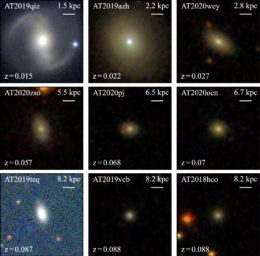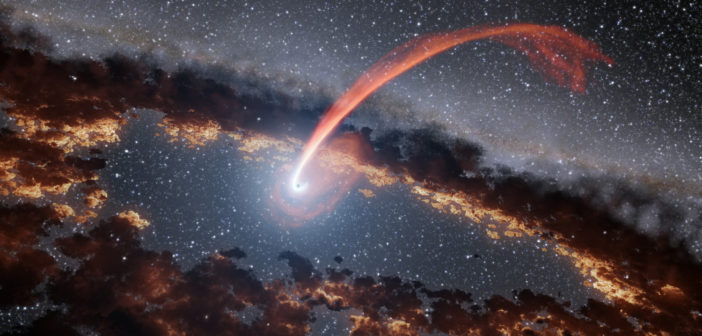A recent study of stars ripped apart by black holes — tidal disruption events — gives insight into the properties of these rare events and reveals a new category of events that lack strong spectral features.
Disruptive Encounters

An example light curve of a tidal disruption event. Click to enlarge. [Adapted from Hammerstein et al. 2022]
By collecting light curves and spectra of tidal disruption events as they brighten and fade over the course of months or years, astronomers have learned much about these dramatic events. In a recent publication, researchers tackled a new sample of shredded stars, aiming to understand how their spectral signatures and light curves map to their underlying physical properties.

A subset of the tidal disruption event–hosting galaxies identified in the study. Click to enlarge. [Adapted from Hammerstein et al. 2022]
Sorting Spectra and Lining Up Light Curves
A team led by Erica Hammerstein (University of Maryland; NASA’s Goddard Space Flight Center) selected a sample of 30 tidal disruption events observed by the Zwicky Transient Facility, which surveys the entire northern night sky every few days. The team used a set of selection criteria such as color and the time it took the event to flare and fade to distinguish the desired stellar shredding from similarly fleeting events, like supernovae.
While the tidal disruption events in the team’s sample have similar colors and light curves, their spectra revealed hidden differences; the strength of hydrogen and helium emission lines varied from event to event, and some events had no hydrogen or helium emission lines at all, revealing a previously unknown class of featureless tidal disruption events. When Hammerstein and collaborators used models to delve into their curated sample of events, they found that the featureless events tended to occur around more massive black holes, and events showing only helium emission lines involved more massive stars than the other three spectral classes.

Cumulative distribution of the mass of the disrupted star for each of the four spectral types: featureless (black), hydrogen emission features (red), helium emission features (blue), hydrogen and helium emission features (green). [Hammerstein et al. 2022]
More to Learn
Analyzing the events’ light curves revealed further trends (too many to discuss here — be sure to check out the original article!), such as a potential connection between the maximum brightness of an event and how long it takes to fade.
As is often the case when we begin to study increasingly large samples of rare phenomena, the data tend to both provide hints and pose questions. Future observatories and surveys tailored to detecting transient events, such as the decade-long Legacy Survey of Space and Time that will kick off at the Vera C. Rubin Observatory in 2024, are poised to reveal many more tidal disruption events — guiding us toward a better understanding of torn-apart stars.
Citation
“The Final Season Reimagined: 30 Tidal Disruption Events from the ZTF-I Survey,” Erica Hammerstein et al 2023 ApJ 942 9. doi:10.3847/1538-4357/aca283
